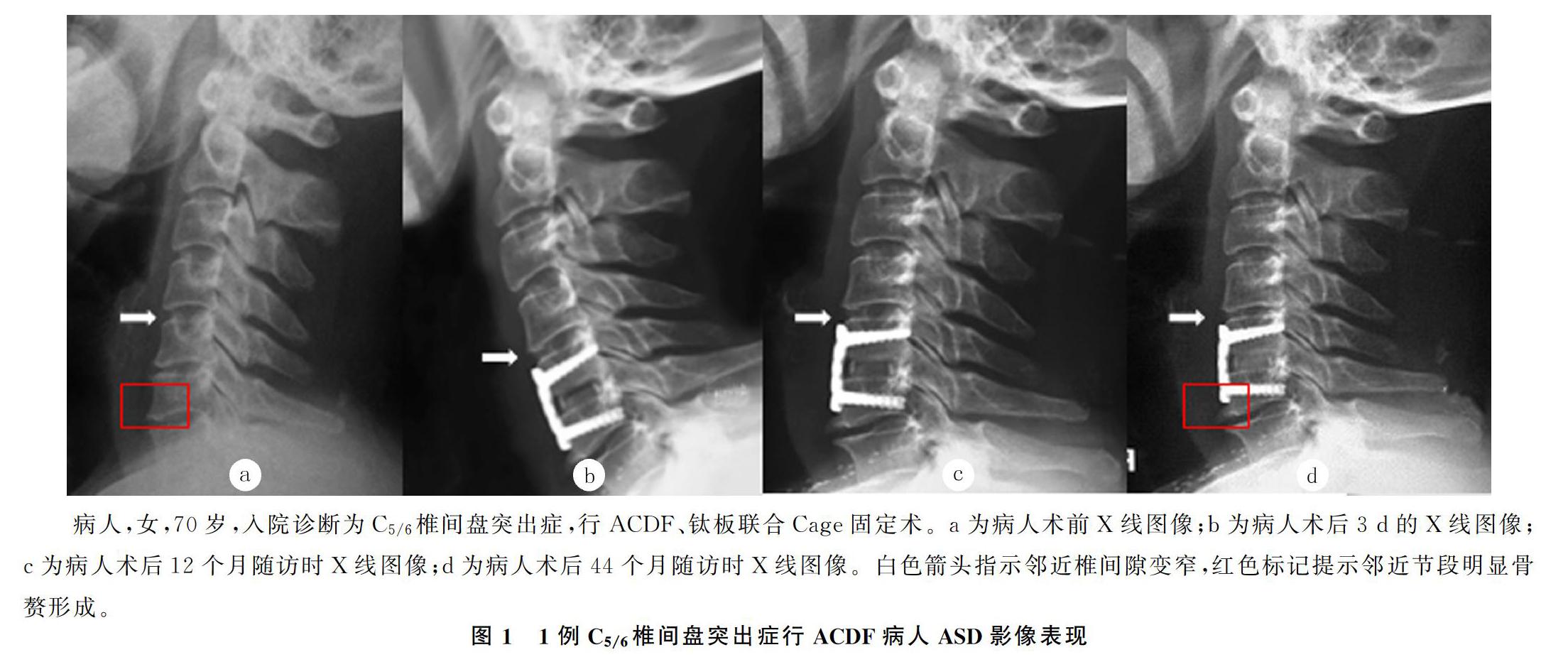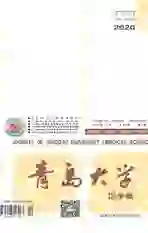单节段颈椎病ACDF术后邻近节段退变及危险因素
2020-09-29孙峰于腾波刘金鑫张益寇建强郑修军
孙峰 于腾波 刘金鑫 张益 寇建强 郑修军


[摘要] 目的 分析颈椎前路椎间盘切除减压植骨融合术(ACDF)治疗单节段颈椎病术后邻近节段退变(ASD)的发病率及危险因素。方法 回顾性分析2015年7月—2017年12月于我科行ACDF治疗单节段颈椎病病人60例的临床及影像学资料。结果 术后随访2年,按照影像学评定标准,ASD的发病率为23.3%(14/60)。ASD组和无退变组病人性别、椎管直径比较差异无统计学意义(P>0.05);ASD组病人年龄大于无退变组,术后Cobb角和钢板距邻近椎间隙之间的距离(PDD)均小于无退变组,差异有显著意义(t=-8.12~2.83,P<0.05)。结论 手术时年龄与ASD的发病率相关,PDD过小、颈椎生理曲度恢复不佳会导致ASD的发生。
[关键词] 脊柱融合术;颈椎;椎间盘切除术;椎间盘退行性变;影响因素分析
[中图分类号] R687.3;R681.5 [文献标志码] A [文章编号] 2096-5532(2020)05-0520-03
doi:10.11712/jms.2096-5532.2020.56.164 [开放科学(资源服务)标识码(OSID)]
[ABSTRACT] Objective To investigate the incidence rate of adjacent segment degeneration (ASD) after anterior cervical discectomy and fusion (ACDF) for single-segment cervical spondylosis and related risk factors. Methods A retrospective analysis was performed for the clinical and imaging data of 60 patients with single-segment cervical spondylosis who underwent ACDF in our department from July 2015 to December 2017. Results After 2 years of follow-up, the incidence rate of ASD was 23.3% (14/60) according to imaging evaluation criteria. There were no significant differences in sex and spinal canal diameter between the ASD group and the non-ASD group (P>0.05), and compared with the non-ASD group, the ASD group had a significantly older age and a significantly lower postoperative Cobb angle and plate-to-disc distance (PDD) (t=-8.12 to 2.83,P<0.05). Conclusion Age at the time of surgery is correlated with the incidence rate of AS, and small PDD and poor recovery of cervical physiolo-gical curvature can cause ASD.
[KEY WORDS] spinal fusion; cervical vertebrae; diskectomy; intervertebral disc degeneration; root cause analysis
頸椎病是脊柱外科常见疾病,颈椎前路椎间盘切除减压融合术(ACDF)是治疗颈椎病的标准术式,术后颈椎生物力学的改变,加速了相邻椎间盘退变的进程,术后发生邻近节段退变(ASD)是ACDF术后的远期并发症之一,也是造成ACDF术后翻修的一个常见原因。本文对ACDF治疗颈椎病病人进行随访,探讨ASD发病率及主要的影响因素。现将结果报告如下。
1 资料与方法
1.1 一般资料
2015年7月—2017年12月,选取在我院进行ACDF手术、采用钛板联合Cage固定方式治疗颈椎病病人60例,男33例,女27例;年龄44~77岁,平均(61.68±6.66)岁。术前诊断均为脊髓型或神经根型颈椎病。入组标准:①明确诊断为颈椎病病人;②行颈前路单节段减压钛板联合Cage融合内固定术。排除标准:①术前邻近节段发生严重退变;②术后发生严重并发症。
1.2 手术方法
取右侧颈部横切口,逐层暴露,将气管、食管与颈部动脉鞘分离,纵行切开气管前筋膜,并将气管、食管牵向左侧,暴露椎前筋膜。在椎间隙插入定位针,C型臂X线透视定位椎间隙,安放撑开螺钉,放置颈椎自动撑开器以恢复颈椎曲度及椎间隙高度;尖刀片切开椎间盘,刮除责任椎间盘至上下软骨终板。充分减压,椎间隙植入大小合适Cage一枚,前方放置钛板,加压固定,放置引流管后逐层缝合。
1.3 ASD诊断标准
病人术前、末次随访均行颈椎正、侧位X线及MRI检查。根据既往文献,参考PARK等[1]对邻近节段骨化的分级方法及MIYAZAKI等[2]建立的基于颈椎间盘MRI表现的退变评价系统,ASD的诊断标准如下:①邻近椎体有明显骨赘形成;②邻近椎间隙明显变窄;③MRI上邻近椎间隙呈低信号且明显塌陷;④MRI上邻近椎间盘突出压迫硬膜囊。以上条件满足其一即诊断为ASD。
[2] MIYAZAKI M, HONG S W, YOON S H, et al. Reliability of a magnetic resonance imaging-based grading system for cervical intervertebral disc degeneration[J]. Journal of Spinal Disorders & Techniques, 2008,21(4):288-292.
[3] HILIBRAND A S, CARLSON G D, PALUMBO M A, et al. Radiculopathy and myelopathy at segments adjacent to the site of a previous anterior cervical arthrodesis[J]. The Journal of Bone and Joint Surgery.American Volume, 1999,81(4):519-528.
[4] CHUNG J Y, PARK J B, SEO H Y, et al. Adjacent segment pathology after anterior cervical fusion[J]. Asian Spine Journal, 2016,10(3):582-592.
[5] SONG K J, CHOI B W, JEON T S, et al. Adjacent segment degenerative disease:is it due to disease progression or a fusion-associated phenomenon? Comparison between segments adjacent to the fused and non-fused segments[J]. European Spine Journal, 2011,20(11):1940-1945.
[6] KATSUURA A, HUKUDA S, SARUHASHI Y, et al. Kyphotic malalignment after anterior cervical fusion is one of the factors promoting the degenerative process in adjacent intervertebral levels[J]. European Spine Journal, 2001,10(4):320-324.
[7] 阿海,關炳瑜,李怀玮,等. 发育性颈椎管狭窄与颈椎前路融合术后邻近节段退变的关系分析[J]. 颈腰痛杂志, 2018,39(4):525-526.
(本文编辑 黄建乡)
